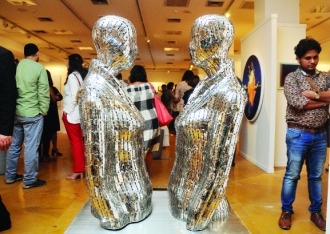Renowned women gallerists come under one roof at the second edition of the Contemporary Art Week in Delhi.
With women empowerment being the talk of the town in every sphere, the Delhi Contemporary Art Week is for the first time bringing together prominent women gallerists under one roof, namely Blueprint 12, Vadehra Art Gallery, Exhibit 320, Shrine Empire, Latitude 28, Gallery Espace and Nature Morte. Needless to say that they have brought their unique sensibilities to curate a larger voice from the south Asian neighbourhood, including countries like Pakistan, Bangladesh, Nepal, Sri Lanka and Afghanistan, and thread together a thematic commonality.
The paintings depict changing civilisations, politics, contrasting emotions of love and separation, economy, ecology, landscape, history, movements, borders, lives, disasters and even tragic stories, in short subjects that have been experienced by everybody. As we enter the Visual Arts gallery, we meet Roshini and Parul Vadehra. “We have got a large range of senior and junior contemporary artists and have kept the canvases at an affordable Rs 10,000,” says Roshini. “We have a salon of paintings, which has been made possible by small-scale painters and artists. But there are a few standout pieces as well; there is this award-winning artist from Kochi, Kerala. Madhusudan’s Lightbox is an original interpretation about colonialism and water trade. There’s Jagannath Panda’s acrylic and fabric on canvas, artists from Patiala, Punjab and Ranbir Kaleka’s presentation of Raja Ravi Verma in the house of Levi.” The Vadehra Art Gallery has surely tried an innovative way of promoting themes.
Anahita Taneja and Shefali Somani draw attention with Bangladeshi artist Tayeba Begum Lipi, who has etched her work with razor blades, a metaphor for why we need to look at society with razor-sharp eyes. “Razor blades were an inspiring medium for her as it takes her back to her childhood. Tayeba was the oldest of 12 siblings and had seen blades used for delivery of babies. She also has seen them being used as tools of domestic violence. A simple everyday object becomes such a powerful metaphor,” shares Anahita. She shows us models by Colombo-born artist Anoli Perera, whose ship-like structure brings in the idea of pilgrimage, movement, history, geography and religious beliefs, and links the two ancient cities of Anuradhapura in Sri Lanka and Varanasi in India. Then there is a city skyline with legs of people dangling from the precipice, a reference to how we are stifling ourselves with the monstrosity of our own creations. Zoya Siddique’s photographs show two different realities with rearview mirrors. “One is the exteriors of a home and the other which is behind the home,” says Anahita.
Mandira Lamba and Ridhi Bhalla, who launched Blueprint-12 in 2012, have put together urban constructs and imagery. They’ve got in Nepali artist Youdhisthir Mahajan whose An Unquiet Mind is a canvas of cut and halved letters. “Youdhisthir cuts each and every text of the book by hand and sticks all the letters below. The process of repeating the same act, cutting and pasting, is to give a meaning and language to the cycle of life and death. It reflects how humans keep repeating the same cycle. While doing this, he goes into a meditative state, which is how he works,” says Mandira.
As the gallerist duo presents a conversation between artists, Ridhi explains how they choose artists who manage to blur boundaries. She points out towards the paintings of Pakistani artist Mehreen Murtaza, whose labour-intensive collages showcase a virtual world that fuses the natural with the mechanical, where technology challenges superstition and myth and Sufi tradition intertwines with pop culture.
We like Sounds from Nowhere by Mahbabur Rahman, another artist from Bangladesh whose work profoundly depicts emotions of pain and separation with references to historical events and man-made disasters like demolition of the Rana plaza. The work shows a number of stainless surgical scissors interlocked in a way that they resemble a guitar box. The sounds of violence, emanating from the vicious grip of scissors, are drowning the music of the guitar as it were. Scissors in his works also evoke the scars of Partition and what Bangladesh had been through during the two wars of 1947 and 1971.
Renu Modi of Gallery Espace has got us Manjunath Kamath’s work that has empty spaces. “The artist talks about history and the empty gaps that are left in the history of evolution,” she tells us.
Revived in New Delhi in 1997, Nature Morte art gallery comes with an international exposure to art that champions conceptual and lens-based artworks. Director Aparajita Jain singles out the works of Anita Dube, Raqs media collective, Jitesh Killat, Asim Waqif, and Tom White. The illustrations represent artificial intelligence, modern civilisations, marital relationships through Franz Kafka’s short stories and modernity that is hurting the environment.
This year the show will be an attempt to streamline the conversation and establish a new paradigm, shaped by a generation of artists who have exhibited around the world by means of residency circuits, biennales and art fairs, which is mature, sustained and part of the global aesthetic. Also presented will be masters of Indian contemporary, who paved the way for the rest with innovative artistic production that has remained future-proof. DCAW will further include outreach initiatives for children, art professionals, and others who are interested in art with panel discussions on art of collecting, maintaining collections and handling of artworks.
Writer: Chahak Mittal
Courtesy: The Pioneer








 OpinionExpress.In
OpinionExpress.In















Comments (0)